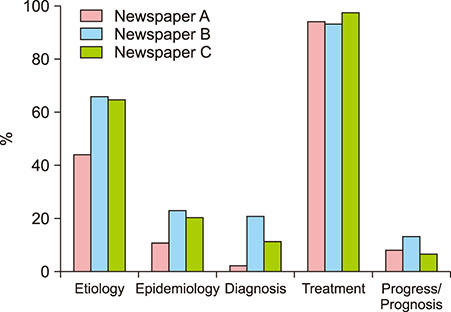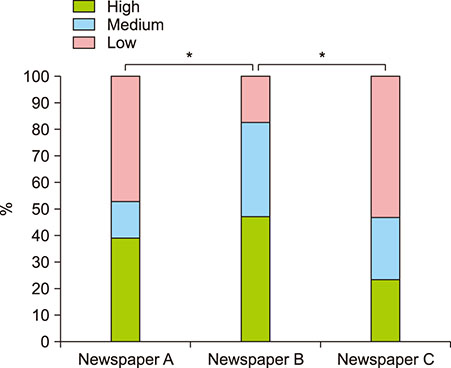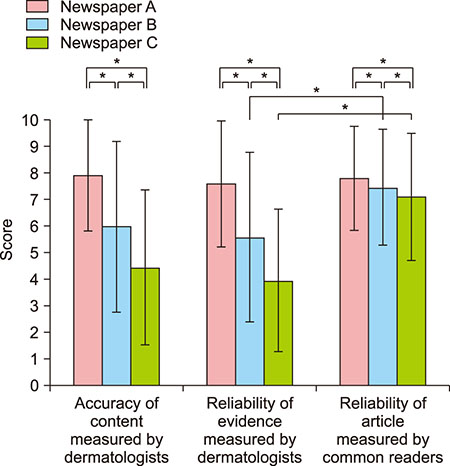Ann Dermatol.
2018 Jun;30(3):309-315. 10.5021/ad.2018.30.3.309.
A Study of the Accuracy and Reliability of Articles about Alopecia in Newspapers
- Affiliations
-
- 1Department of Dermatology, Inje University Busan Paik Hospital, Inje University College of Medicine, Busan, Korea. derma09@hanmail.net
- KMID: 2419172
- DOI: http://doi.org/10.5021/ad.2018.30.3.309
Abstract
- BACKGROUND
There is growing interest in alopecia among the general population. Many people obtain information from easily accessible media rather than from doctors; thus, the media can play an important role in shaping public opinion.
OBJECTIVE
The goal of this study was to evaluate the content and reliability of newspaper articles on alopecia.
METHODS
Newspapers were categorized into three groups: one group of print newspapers and two groups of online newspapers. Online newspapers were further divided into two groups according to type of publishing company; one publishes both print and online newspapers and the other publishes online newspapers only. The most frequently subscribed or circulated newspaper in each group was selected. Articles containing information on alopecia were selected from 3 years of each newspaper and evaluated for reliability.
RESULTS
Most articles in each group used the general term "alopecia" instead of naming a specific hair loss disease. The majority of articles were based on consultation with experts. Assessment of the accuracy of articles with three grade scales showed that the percentage with high accuracy was 38.9%, 47.2%, and 23.3%. Assessment of reliability scores for five selected articles in each group showed that there were statistically significant differences between common readers and dermatologists (p < 0.05).
CONCLUSION
The results of this study suggest that closer monitoring of the media is required to supply easily accessible, balanced, and trustworthy information regarding alopecia.
Keyword
Figure
Reference
-
1. Internet World Stats [Internet]. Bogota: Internet World Stats;2015. 02. 03. update 2017 Dec 31. cited 2015 Feb 3. Available from: http://www.Internetworldstats.com/stats.htm.2. Choi JE, Ahn HH, Kye YC. A study for the credibility of dermatologic articles in free newspapers. Korean J Dermatol. 2007; 45:1132–1138.3. Cho HM, Choi JE, Ko NY, Seo SH, Ahn HH, Kim SN, et al. Descriptive study of dermatologic issues appeared on television over seventeen months (Jan. 2004∼May 2005). Korean J Dermatol. 2006; 44:785–790.4. Kilkenny M, Stathakis V, Jolley D, Marks R. Maryborough skin health survey: prevalence and sources of advice for skin conditions. Australas J Dermatol. 1998; 39:233–237.
Article5. Bang YD, Park JY. News selection and headline editing of the internet news-a case study of media daum and chosun.com. Korean J Broadcast Telecommun Stud. 2009; 23:86–124.6. Chang MY, Kim JW, Rhee CS. The quality of health information on allergic rhinitis, rhinitis, and sinusitis available on the internet. Allergy Asthma Immunol Res. 2015; 7:141–147.
Article7. Health Insurance Review Assessment Service [Internet]. Wonju: Health Insurance Review Assessment Service;2014. 07. updated 2017 Dec. cited 2014 Jul. Available from: http://opendata.hira.or.kr/op/opc/olapMfrnIntrsIlnsInfo.do.8. Elliott AD, Bartel AF, Simonson D, Roukis TS. Is the internet a reliable source of information for patients seeking total ankle replacement? J Foot Ankle Surg. 2015; 54:378–381.
Article9. Pithon MM, dos Santos ES. Information available on the internet about pain after orthognathic surgery: a careful review. Dental Press J Orthod. 2014; 19:86–92.
Article10. Akbari K, Som R. Evaluating the quality of internet information for bariatric surgery. Obes Surg. 2014; 24:2003–2006.
Article
- Full Text Links
- Actions
-
Cited
- CITED
-
- Close
- Share
- Similar articles
-
- The Image of Nursing projected in Newspapers
- Print Media Coverage of Post-Traumatic Stress Disorder: Content Analysis of Three Major Korean Newspapers
- A Study for the Credibility of Dermatologic Articles in Free Newspapers
- Evaluation of Child Health Information Articles in Newspapers
- Analysis of Dietary Informations in Newspapers and Magazine for Children (2002)






